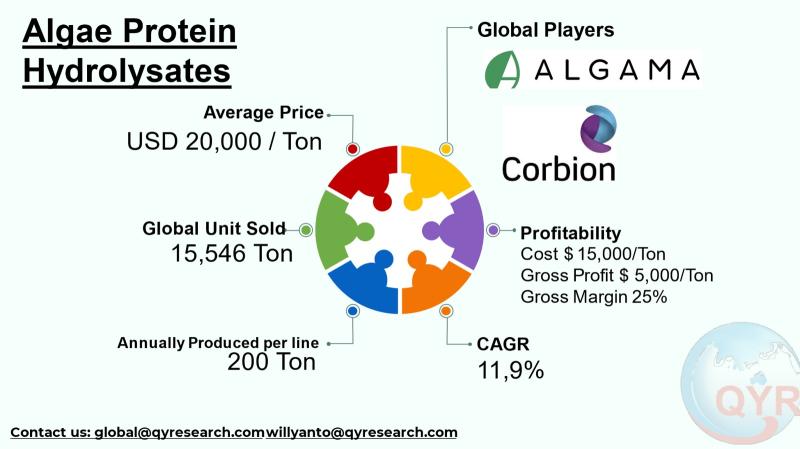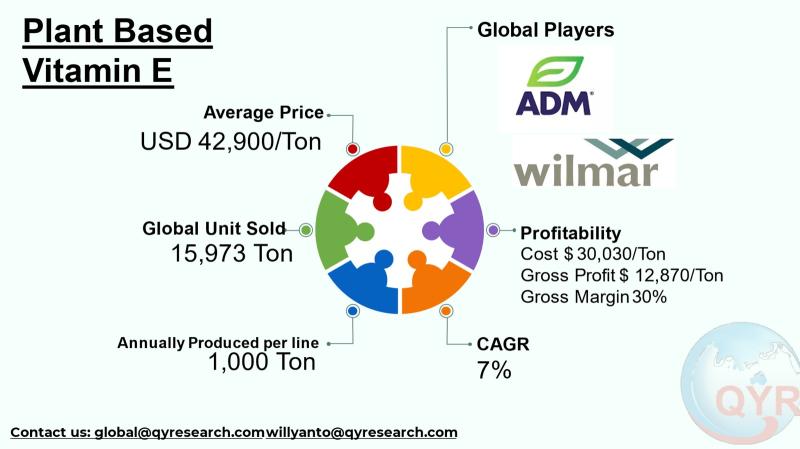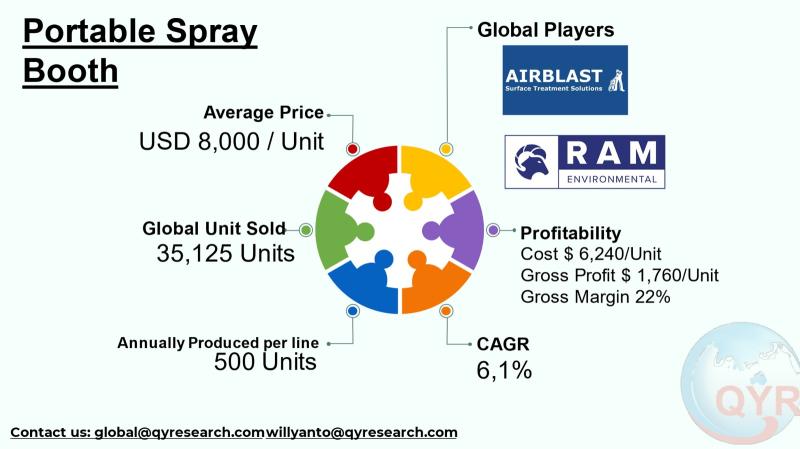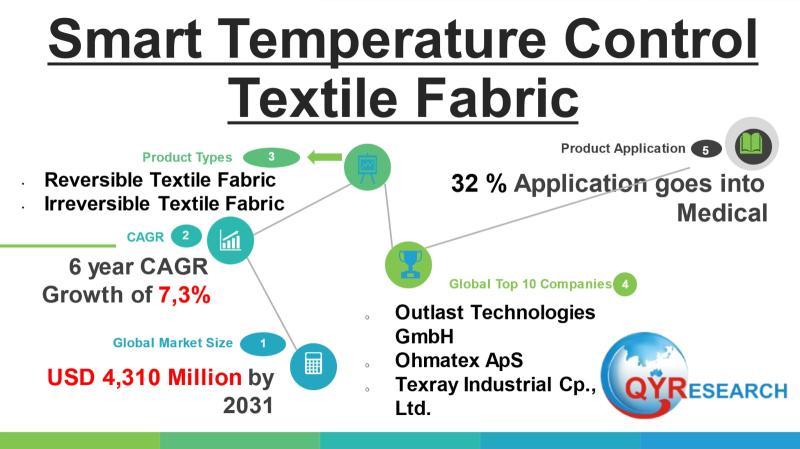Press release
Smart Temperature-Control Textile Fabric Market to Reach 7,3 % CAGR by 2031 TOP 10 Company Globally
Smart temperaturecontrol textile fabrics are engineered to dynamically manage wearer comfort by autonomously adjusting thermal insulation, moisture release, and heat transfer. These smart textiles often incorporating phase-change materials (PCMs), conductive fibers, and embedded sensors are deployed in activewear, bedding, medical garments, military uniforms, and automotive interiors. Their ability to regulate body temperature in real time through passive or active mechanisms makes them appealing for wellness, performance, and safety applications. Rising consumer demand for adaptive clothing, coupled with increasing recognition of smart sleep, medical recovery, and athletic performance benefits, is propelling adoption.The global market for smart temperaturecontrol textile fabric was valued at approximately USD 2,467 million in 2024, with estimated unit volume of around 900 million square meters sold, implying an average selling price (ASP) of about USD 2.74 per m2. Forecasts project a steady expansion to around USD 4,310 million by 2031, reflecting a CAGR of 7,3% from 2024 to 2031.
.
Latest Trends and Technological Developments
On July 2025, the Asia Pacific smart textile materials market reached USD 2.5 billion in 2024, with a forecasted CAGR of 9.8% through 2033 to USD 5.8 billion, signaling strong regional momentum in temperatureregulating textiles. In February 2025, SigmaFit (Egypt) unveiled an AIdriven textile design model that sequences temperature-sensitive fiber placement to cool specific body zones effectively a potential breakthrough in heatadaptive fabric design. Additionally, research into nanostructured coatings enabling radiative cooling and warming the ability of fabric surfaces to passively emit or retain infrared radiation is advancing performance without electronics, offering multifunctional temperature control.
AsiaPacific leads smart temperaturecontrol textile demand. As of 2024, the region accounted for over 45% of global smart textile exports and more than 60% of wearable tech production capacity, driven by China, India, Japan, and South Korea. China alone produces over one-third of regional smart fabric capacity. Growth is especially strong in healthcare (30% share), sportswear, and defense textiles. India's healthcare smart textile segment is expanding at 31.7% CAGR. Local innovation hubs such as the Hong Kong Research Institute of Textiles and Apparel (HKRITA) are investing heavily in green, temperature-adaptive textile R&D.
Get Full PDF Sample Copy of Report: (Including Full TOC, List of Tables & Figures, Chart)
https://www.qyresearch.com/sample/4755379
Smart Temperature Control Textile Fabric by Type:
Reversible Textile Fabric
Irreversible Textile Fabric
Smart Temperature Control Textile Fabric by Application:
Fashion
Medical
Military
Aerospace
Others
Global Top 10 Key Companies in the Smart Temperature Control Textile Fabric Market
Milliken & Company
Texhong Textile Group Ltd(天虹纺织集团有限公司)
Teijin Frontier Co. Ltd.
Ohmatex ApS
Sensoria Inc.
Outlast Technologies GmbH
Welspun Living Limited
Arvind Limited
Tex-Ray Industrial Co.,Ltd
HeiQ
Regional Insights
While Southeast Asia's overall textile market reached USD 39.9 billion in 2024, smart temperature textiles represent a smaller subset, likely USD 200-300 million, yet growing rapidly at ~1012% CAGR depending on subregions and government contracts. Indonesia, Malaysia, Vietnam, Thailand, and the Philippines are adopting adaptive textiles in uniforms, sportswear, and hospitality sectors. Military procurement in Malaysia and Singapore increasingly spec smart uniforms with thermal regulation and biometric layers. Adoption is still early-stage, but infrastructure investments and exports to developed markets are helping develop supply chains.
Smart Temperature Control Textile Fabric by Region:
North America
Europe
China
Japan
India
South East Asia
Despite high potential, smart temperaturecontrol textiles face challenges including high material and fabrication costs, complexity in integrating PCMs or sensors, limited washability and durability, and inconsistent standards. Regulatory uncertainties around data privacy (for garments collecting biometric signals) and lack of unified performance benchmarks slow institutional adoption. Consumer awareness is still nascent in many Asia and Southeast Asia markets, and price sensitivity can impede entry in mass apparel channels.
Manufacturers should prioritize scalable passive temperaturecontrol fabrics that balance performance with durability and washability. Localizing production and finishing in Southeast Asia reduces cost exposure and improves logistics. Strategic partnerships with healthcare providers, sports brands, and defense forces can anchor initial volume contracts. Licensing or co-branding with fitness and wellness wearable firms can accelerate consumer awareness. Research alliances e.g., with universities or institutes like HKRITA can fast-track commercialization of nanotech radiative cooling or AIpatterned thermal channels. Finally, premium bedding or medical textile applications may offer higher ASPs and recurring revenue.
Product Models
Smart temperature-control textile fabrics represent an innovative class of advanced materials designed to adapt to environmental or body temperature changes. These textiles can actively respond by altering their insulation, color, or moisture management properties, improving comfort, performance, or energy efficiency.
Reversible Textile Fabrics which adjust their properties multiple times with changing temperatures. Notable products include:
Outlast® Thermocules by Outlast Technologies: PCM (phase change material) embedded textile that absorbs, stores, and releases heat repeatedly, used in bedding, activewear, and uniforms.
HeiQ Smart Temp by HeiQ Materials AG: An intelligent thermoregulating fabric treatment that dynamically adapts to body heat, ideal for sportswear and travel garments.
PCM-Coated Nylon by BASF: Engineered for reusable cooling or heating garments, using microencapsulated paraffin wax that repeatedly melts and solidifies with temperature change.
Schoeller c_change® Fabric: Swiss-made fabric that opens or closes polymer structures in response to body heat and moisture, enhancing thermal comfort.
Polartec® Alpha® Direct: A highly breathable insulating fabric that adapts to heat and moisture levels, offering dynamic warmth for activewear and military gear.
Irreversible Textile Fabrics which undergo a permanent change after reaching a certain threshold temperature. Examples include:
E-TINT® Thermochromic Safety Panels (by AlphaMicron): Thermochromic fabric for industrial environments that irreversibly signals heat spikes and exposure breaches.
ThermAlert Heat-Sensitive Uniform Fabric: Developed for industrial workers, it changes color permanently to signal thermal exposure exceeding safe limits.
HeatCheck Smart Label Fabric: An irreversible label fabric sewn into uniforms and medical gowns that triggers a permanent visual marker when heat limits are exceeded.
HeatSense FR Tagging Fabric (by Glen Raven): Flame-retardant irreversible marker fabric used in high-performance garments, designed to indicate one-time temperature overload events in firefighting suits.
SafeTemp SmartWear Fabric Label (by 3M Protective Solutions): Incorporated into mining or oil field garments, the fabric patch shows irreversible discoloration after thermal breach, ensuring workers replace compromised PPE.
Smart temperaturecontrol textile fabrics represent an emerging high-growth niche within the broader smart textile market. Valued at approximately USD 2,467 million in 2024, the segment is projected to exceed USD 4,310 million by 2031 at an estimated 7,3%CAGR. Asia-Pacific leads production and innovation, while Southeast Asia is rapidly developing market traction. As wearable, healthcare, and military textiles converge with performance and thermal regulation demands, smart fabrics with temperature-control functionality position themselves at the intersection of comfort, safety, and adaptive technology innovation.
Investor Analysis
Smart temperaturecontrol fabrics sit at the frontier of textile innovation, merging material science (PCM, nanocoating) with wearable comfort. With industry growth anticipated at ~18% CAGR and segment expansion across high-value end-uses, it represents a scalable opportunity.
Investors might fund advanced textile startups, co-development with technologists (e.g. AI cooling designs), or partner with OEMs in healthcare or defense. Supporting regional finishing and coating facilities in ASEAN could reduce supply chain complexity and open premium ASP markets (e.g. bedding, medical garments).
These fabrics align with megatrends wellness, personalization, climate adaptation and offer both consumer and B2B monetization paths. Asia leads both production and demand; Southeast Asia offers early-stage growth and cost advantages. Strategic investment now could yield technological leadership and strong returns in the evolving smart textile ecosystem
Request for Pre-Order Enquiry On This Report
https://www.qyresearch.com/customize/4755379
5 Reasons to Buy This Report
Accurate market sizing USD 2,467 million in 2024 with volume and ASP dynamics.
Sharp regional focus on Asia-Pacific dominance and SEA emergence.
Trend deep-dives including PCM, AI-controlled cooling designs, and nanotech coatings.
Strategic guidance for market entry via healthcare, military, consumer, and bedding channels.
Competitive maps linking global leaders with local and startup innovators.
5 Key Questions Answered
What is the market size, volume sold, and ASP for smart temperaturecontrol textile fabrics in 20242031?
How do Asia-Pacific and Southeast Asia compare in terms of demand, innovation, and growth?
What are the latest fabric technologies for passive cooling or active thermal regulation?
Which applications offer highest price premiums and adoption potential?
Who are the top global and regional players shaping temperature-control fabric innovation?
Chapter Outline
Chapter 1: Introduces the report scope of the report, executive summary of different market segments (by region, product type, application, etc), including the market size of each market segment, future development potential, and so on. It offers a high-level view of the current state of the market and its likely evolution in the short to mid-term, and long term.
Chapter 2: key insights, key emerging trends, etc.
Chapter 3: Manufacturers competitive analysis, detailed analysis of the product manufacturers competitive landscape, price, sales and revenue market share, latest development plan, merger, and acquisition information, etc.
Chapter 4: Provides profiles of key players, introducing the basic situation of the main companies in the market in detail, including product sales, revenue, price, gross margin, product introduction, recent development, etc.
Chapter 5 & 6: Sales, revenue of the product in regional level and country level. It provides a quantitative analysis of the market size and development potential of each region and its main countries and introduces the market development, future development prospects, market space, and market size of each country in the world.
Chapter 7: Provides the analysis of various market segments by Type, covering the market size and development potential of each market segment, to help readers find the blue ocean market in different market segments.
Chapter 8: Provides the analysis of various market segments by Application, covering the market size and development potential of each market segment, to help readers find the blue ocean market in different downstream markets.
Chapter 9: Analysis of industrial chain, including the upstream and downstream of the industry.
Chapter 10: The main points and conclusions of the report.
Contact Information:
Tel: +62 896-3769-3166(Whatsapp)
Email: willyanto@qyresearch.com; global@qyresearch.com
Website: www.qyresearch.com
About Us
QYResearch founded in California, USA in 2007. It is a leading global market research and consulting company. With over 18 years experience and professional research team in various cities over the world QY Research focuses on management consulting, database and seminar services, IPO consulting, industry chain research and customized research to help our clients in providing non-linear revenue model and make them successful. We are globally recognized for our expansive portfolio of services, good corporate citizenship, and our strong commitment to sustainability. Up to now, we have cooperated with more than 66,000 clients across five continents. Let's work closely with you and build a bold and better future.
This release was published on openPR.
Permanent link to this press release:
Copy
Please set a link in the press area of your homepage to this press release on openPR. openPR disclaims liability for any content contained in this release.
You can edit or delete your press release Smart Temperature-Control Textile Fabric Market to Reach 7,3 % CAGR by 2031 TOP 10 Company Globally here
News-ID: 4127219 • Views: …
More Releases from QY Research

Premium Proteins at Scale: The Technologies, Trends, and Players Transforming th …
Algae protein hydrolysates are specialty protein ingredients produced by breaking down algae-derived proteins into shorter peptides and amino acids through enzymatic, chemical, or thermal hydrolysis processes. These ingredients are prized for their high digestibility, concentrated amino acid profiles, and functional properties that suit nutraceuticals, specialized foods, animal feed, cosmetics and agricultural biostimulants. Producers and buyers view algae protein hydrolysates both as a sustainable alternative to conventional protein hydrolysates and as…

Plant-Based Vitamin E Market Poised for 7% CAGR: Asia-Pacific and ASEAN Lead the …
The global market for plantbased Vitamin E has garnered increasing attention as consumers worldwide shift toward clean-label, natural, and plant-derived nutrients. With rising health consciousness, demand for natural antioxidants especially for supplements, fortified foods, cosmetics, and functional beverages continues to climb. This report provides a comprehensive analysis of the global plantbased Vitamin E industry, with special emphasis on Asia and Southeast Asia, exploring market size, pricing, cost structure, production capacity,…

Portable Spray Booth Market Set to Soar: Asia and ASEAN Drive Innovation, IoT Ad …
The portable spray booth market serves a wide spectrum of users from small automotive repair shops and furniture finishers to large industrial contractors seeking on-demand finishing capacity without the investment and footprint of permanent booths. Portable booths range from tabletop and tent/frame systems for hobbyists and small shops to inflatable and modular containerized systems used on-site for larger equipment. These solutions are prized for lower capital cost, rapid deployment, and…
Top 30 Indonesian Public Companies Q3 2025 Revenue & Performance
1) Sector overview overall performance (Q3 2025 snapshot)
Q3 2025 in Indonesias listed energy sector was dominated by coal-price weakness (Newcastle / ICI indexes down vs the prior year) and mixed operational results across miners and oil & gas firms. Several large coal miners and integrated groups recorded lower year-on-year net results in Q3 and for 9M25 as ASP (average selling prices) softened; however, some companies reported improved production volumes…
More Releases for Fabric
The Difference Between Rib fabric and Jersey fabric
When it comes to choosing fabrics for clothing, the options can be overwhelming. Two popular choices are rib fabric and jersey fabric, each with its own unique characteristics and uses.
Jersey fabric is a type of weft knitted fabric known for its elasticity in both the warp and weft directions. This fabric has a smooth surface, a naturally clean texture, and a soft, fine feel. It is comfortable to wear and…
Fabric Testing and Fabric Testers
CHINA, HEFEI (February 27, 2024)-Based on the material classification, the textile testing laboratory's testing items are separated into three categories: fiber, yarn, and fabric testing. We will present pertinent fabric testing information based on the various fabric qualities in the content that follows.https://fyitester.com/textile-testing-equipments/fabric-garment/
The fabric solid degrees
The most common mechanical damage to textiles during usage is tensile fracture, tearing, bursting, and abrasion.
Tensile performance testing
The fabric's mechanical deformation law when it is…
Coated Fabric Market Global Coated Fabric Market, Coated Fabric Market, Coated F …
Global Coated Fabric Market Research report is an in-depth study of the market Analysis. Along with the most recent patterns and figures that uncovers a wide examination of the market offer. This report provides exhaustive coverage on geographical segmentation, latest demand scope, growth rate analysis with industry revenue and CAGR status. While emphasizing the key driving and restraining forces for this market, the report also offers a complete study of…
Fabric detergents
Market Overview
With the global economic recovery, more people look at the increasing environmental factors, especially underdeveloped regions that have a wide range of people, and fast economic growth, the need will increase. The industry is a high-technology and high-profit-based industry, the research team maintains a very positive outlook. New teams are welcomed to enter the market world. The fabric detergents industry is influenced by the economic guidelines, so…
Global Textile and Fabric Finishing and Fabric Coating Mills Market | Textile an …
The textile and fabric finishing and fabric coatings market consists of sales of textile and fabric finishings and fabric coatings by entities (organizations, sole traders and partnerships) that operate mills that produce textile and fabric finishings or fabric coatings.
According to the report analysis, ‘Textile and Fabric Finishing and Fabric Coating Mills Global Market Report 2020-30: Covid 19 Impact and Recovery’ states that the worldwide textile and fabric finishing and fabric…
Global Denim Fabric Market: Analysis, Technologies, Forecasts and Types: Light D …
Denim Fabric Market Report:
Summary: Excellence consistency maintains by Garner Insights in Research Report in which studies the global Denim Fabric market status and forecast, categorizes and Equipment market value by manufacturers, type, application, and region.
The report on Global Denim Fabric Market studies the historical data and evaluates the current market scenario so as to project the flight of the market during the next couple of years. This study has been…
